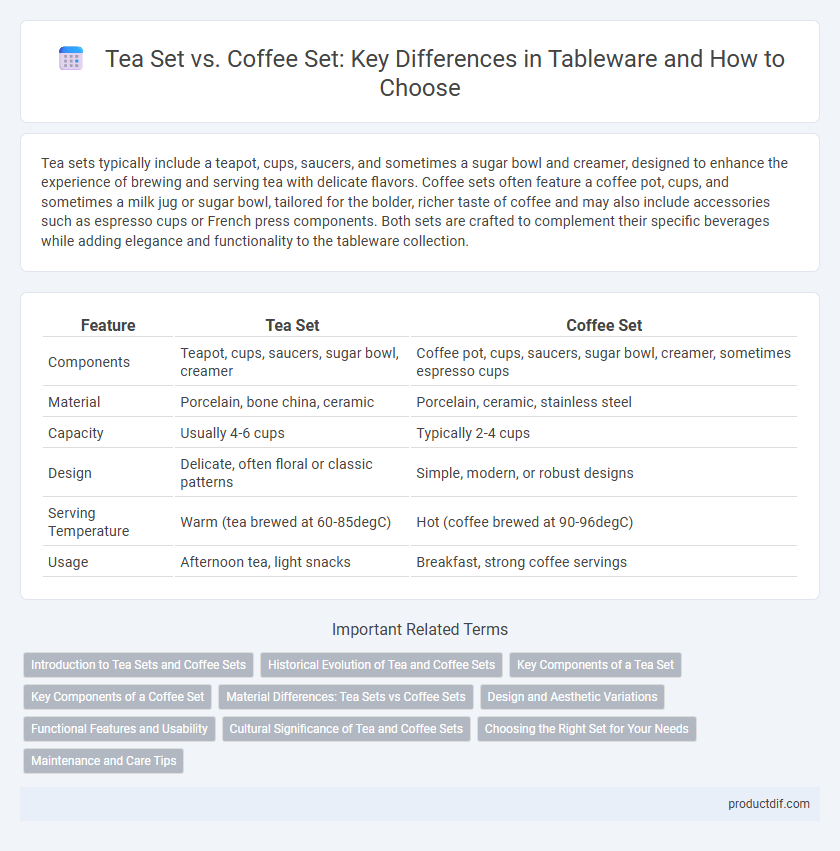Tea sets typically include a teapot, cups, saucers, and sometimes a sugar bowl and creamer, designed to enhance the experience of brewing and serving tea with delicate flavors. Coffee sets often feature a coffee pot, cups, and sometimes a milk jug or sugar bowl, tailored for the bolder, richer taste of coffee and may also include accessories such as espresso cups or French press components. Both sets are crafted to complement their specific beverages while adding elegance and functionality to the tableware collection.
Table of Comparison
| Feature | Tea Set | Coffee Set |
|---|---|---|
| Components | Teapot, cups, saucers, sugar bowl, creamer | Coffee pot, cups, saucers, sugar bowl, creamer, sometimes espresso cups |
| Material | Porcelain, bone china, ceramic | Porcelain, ceramic, stainless steel |
| Capacity | Usually 4-6 cups | Typically 2-4 cups |
| Design | Delicate, often floral or classic patterns | Simple, modern, or robust designs |
| Serving Temperature | Warm (tea brewed at 60-85degC) | Hot (coffee brewed at 90-96degC) |
| Usage | Afternoon tea, light snacks | Breakfast, strong coffee servings |
Introduction to Tea Sets and Coffee Sets
Tea sets typically include teapots, cups, saucers, and sometimes sugar bowls and creamers, designed to brew and serve various types of tea. Coffee sets often consist of coffee pots, cups, saucers, and accessories like creamers and sugar bowls, tailored for brewing and enjoying coffee. Both sets are crafted to enhance the drinking experience, reflecting cultural differences in serving tea and coffee.
Historical Evolution of Tea and Coffee Sets
Tea sets and coffee sets both evolved distinctly, reflecting cultural preferences and social rituals over centuries. Tea sets originated in East Asia during the Tang Dynasty, emphasizing porcelain craftsmanship and graceful designs, while coffee sets emerged in the Ottoman Empire, favoring metal and ornate detailing to complement coffee's exotic appeal. The 17th and 18th centuries saw Europe adapt both sets, with tea sets becoming symbols of refinement during the English Georgian period and coffee sets associated with the social coffeehouse culture of the Enlightenment.
Key Components of a Tea Set
A tea set typically includes a teapot, teacups with saucers, a sugar bowl, and a milk or cream pitcher designed for serving tea. The teapot is often crafted with a spout and lid optimized for steeping and pouring loose leaf tea efficiently. In contrast, a coffee set may emphasize items like a coffee pot, coffee cups, and sometimes a milk jug, focusing on components suited for brewing and serving brewed coffee.
Key Components of a Coffee Set
A coffee set typically includes a coffee pot, sugar bowl, creamer, and cups with saucers, designed for serving brewed coffee with added milk or cream. The coffee pot is specially crafted with a narrow spout and often a double-walled design to retain heat, distinguishing it from tea pots. Cups in coffee sets are generally smaller than tea cups, reflecting the stronger, concentrated nature of coffee beverages.
Material Differences: Tea Sets vs Coffee Sets
Tea sets are commonly crafted from delicate porcelain or fine bone china, emphasizing thin walls and translucency for enhanced heat retention and aesthetic appeal. Coffee sets often utilize heavier materials such as stoneware or earthenware, designed to maintain higher temperatures and accommodate stronger brews with thicker cups. The choice of material reflects the traditional serving style and temperature requirements unique to tea and coffee preparation.
Design and Aesthetic Variations
Tea sets often emphasize delicate, intricate designs with floral patterns and pastel colors, enhancing a refined, traditional aesthetic. Coffee sets typically feature bolder shapes, darker hues, and minimalist or modern designs to suit a robust and contemporary vibe. The material choice also varies, with porcelain common in tea sets for elegance, while stoneware and glass frequently appear in coffee sets for durability and style.
Functional Features and Usability
Tea sets often include a teapot, cups with saucers, a creamer, and a sugar bowl designed for steeping and serving loose leaf or bagged tea, emphasizing temperature retention and elegant pouring features. Coffee sets typically consist of a coffee pot, cups, and a tray with sturdier, insulated designs to maintain higher temperatures and accommodate stronger brews and milk frothing accessories. Usability differences arise from the tea set's focus on delicate handling and steeping precision, while coffee sets prioritize durability, heat retention, and ease of serving brewed coffee efficiently.
Cultural Significance of Tea and Coffee Sets
Tea sets hold profound cultural significance in many Asian and British traditions, symbolizing hospitality, refinement, and ceremonial practices, often featuring delicate porcelain and intricate designs. Coffee sets, central to Middle Eastern, European, and Latin American cultures, represent social connection and energy, typically crafted from robust materials like silver or ceramic to withstand frequent use. Both tea and coffee sets embody distinct cultural identities and rituals, reflecting the historical and social values associated with their respective beverages.
Choosing the Right Set for Your Needs
Selecting the right tea set or coffee set depends on your beverage preferences and serving style. Tea sets typically include teapots, cups with saucers, and sometimes a sugar bowl and creamer, designed for brewing and serving loose leaf tea or tea bags. Coffee sets often feature coffee pots or French presses, mugs or demitasse cups, and accessories like milk pitchers, catering to espresso, drip, or French press coffee preparation.
Maintenance and Care Tips
Tea sets typically require delicate handling, as porcelain or fine bone china components can be prone to chipping; hand washing with mild detergent and avoiding abrasive scrubbers preserves their intricate designs. Coffee sets, often made from sturdier materials like stoneware or glass, tolerate dishwasher cleaning but benefit from regular descaling of carafes and thorough rinsing to prevent coffee oil buildup. Always air-dry both sets to avoid moisture damage and store them in a dry, dust-free environment to maintain their longevity and aesthetic appeal.
Tea Set vs Coffee Set Infographic

 productdif.com
productdif.com